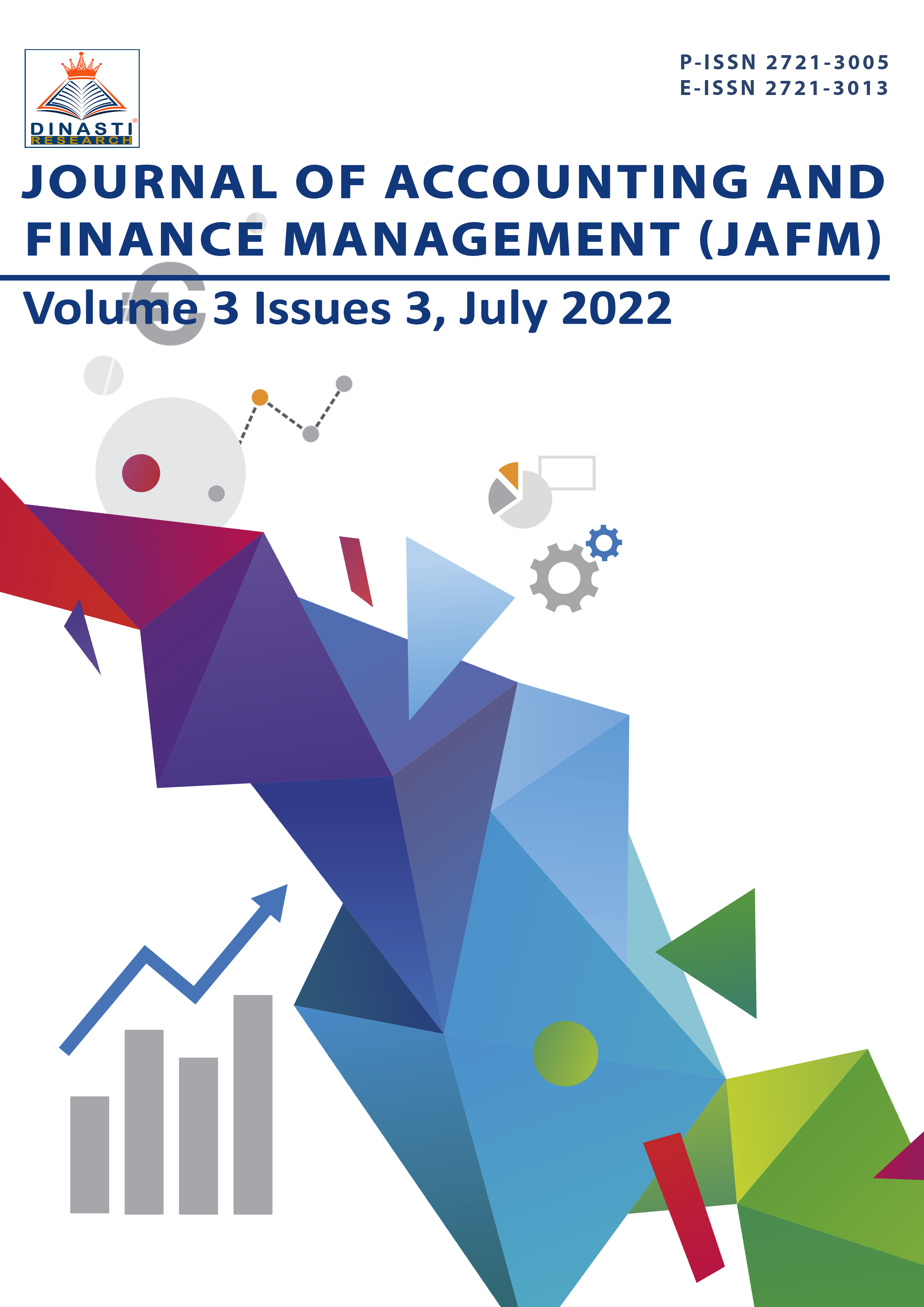Job Satisfaction and Organizational Commitment as Factors Affecting Employee Withdrawal at Army Flight Center
DOI:
https://doi.org/10.38035/jafm.v3i3.102Keywords:
Job Satisfaction, Organizational Commitment, Employee WithdrawalAbstract
The Army Aviation Center is the central implementing agency of the Indonesian Army, in carrying out its main tasks using aircraft requires a high level of security. One of the factors that support the creation of high security is by trying to overcome the problem of human resources, this is a serious concern by the leadership. The purpose of this study is to analyze the influence of organizational commitment and job satisfaction on employee withdrawals and the effect of the level of organizational commitment and job satisfaction together on the withdrawal of civil servants at the Army Aviation Center, either simultaneously or partially. The research method in this paper is quantitative, with a path analysis research model with a view to solving problems by collecting data, compiling data, then analyzing statistically and interpreting it to further obtain a valid result using the calculation of the Statistical Product And Service Solutions application. Based on the results of statistical data processing carried out, the research results obtained include organizational commitment has an influence on Employee Withdrawal and while job satisfaction on Employee Withdrawal is said to have an effect.
References
Afrizal, Rifki. 2012. “Analisis Pengaruh Gaya Kepemimpinan, Lingkungan Kerja dan Kompensasi Terhadap Kepuasan Kerja Karyawan PT. Nindya Karya Persero”. Jurnal Ekonomi dan Bisnis, Vol.3 h:83-97.
Arika. (2011). Jurnal artikel Analisis Beban Kerja Ditinjau Dari Faktor Usia Dengan Pendekatan Recommended Weight Limit. Vol. 05, No. 2. Agustus 2011. ISSN: 1978-1105. https://ejournal.unpatti.ac.id/ppr_iteminfo_lnk.php?id=130 diakses 12 September 2020.
Afrizal, Rifki. 2012. “Analisis Pengaruh Gaya Kepemimpinan, Lingkungan Kerja dan Kompensasi Terhadap Kepuasan Kerja Karyawan PT. Nindya Karya Persero.” Jurnal Ekonomi dan Bisnis, Vol.3 h:83-97.
Beehr, T. A., and Gupta, N."A Note on the Structure of Employee Withdrawal." Organzzational Behavior and Human Performance, 1978, 21, 73-79.
Blau, G, 1995 “Influence of Group Lateness on Individual Lateness: A Cross-Level Examination”, The Academy of Management Journal Vol. 38, No. 5 (Oct., 1995), pp. 1483-1496 Published by: Academy of Management. http://www.jstor.org/stable/256867 Page Count: 14 diakses 12 September 2020.
Blau, G. (1994). “Developing and testing a taxonomy of lateness behavior.” Journal of Applied Psychology, 79 (6), 959-970.
DeLonzor, D. (2005). Running late: Dealing with chronically late employees who cost the company in productivity and morale. HR Magazine, 50(11), 109.
G.H. Ironson, P.C. Smith, M.T. Brannick, W.M. Gibson, and K.B. Paul, “Construction of a Job in General Scale: A Comparison of Global, Composite, and Specific Measures,” Journal of Applied Psychology 74 (1989), pp. 193–200; and S.S. Russell, C. Spitzmuller, L.F. Lin, J.M. Stanton, P.C. Smith, and G.H. Ironson, “Shorter Can Also Be Better: The Abridged Job in General Scale,” Educational and Psychological Measurement 64 (2004), pp. 878–93.
Koslowsky, M. (2000). A new perspective on employee lateness. Applied Psychology: An International Review, 49: 390-407.
Koslowsky, M. A. Sagie, M. Krausz and A. D. Singe: 1997, ‘Correlates of Employee Lateness: Some Theo- retical Considerations’, Journal of Applied Psychology 82(1), 79–88.
Koslowsky, M.: 2009, ‘A Multi-Level Model of Withdrawal: Integrating and Synthesizing Theory and Findings’, Human Resource Management Review 19, 283-303.
Kusniati, Luluk. 2016. Penggunaan face recognition untuk meningkatkan disiplin kehadiran pegawai negeri sipil. (Jurnal manajemen Publik, Volume 25, Nomor 1 Maret 2016).
Laczo, R. M. L. and Hanisch, K. A. 2000. An examination of behavioral families organizational withdrawal in volunteer workers and paid employees. Human Resource Management Review, 9, 4, 453–77.
Manuaba, A. (2000) Ergonomi, Kesehatan Keselamatan kerja, dalam Wygnyosoebroto, S. & Wiranto, S. E. “Eds. Processing Seminar Nasional Ergonomi.Edition, Singapore.
Nicholson, N., & Goodge, P. M. The influence of social, organizational, and biographical fac- tors on female absence. Journal of Management Studies, 1976, 13, 234-254.
Orly Shapira-Lishchinsky & Shmuel Even-Zohar ; Withdrawal Behaviors Syndrome: An Ethical Perspective ;Journal of Business Ethics 103 (3):429-451 (2011)
Sagie, A. (1998). Employee absenteeism, organizational commitment, and job satisfaction: Another look. Journal of Vocational Behavior, 52(2), 156-171.
Shah, S. S. H. et al. (2011). Workload and Performance of Employees. Interdisciplinary Journal of Contemporary Research in Business. Vol 3, No.5.
Arnold, John, 1958. Work psychology : understanding human behaviour in the workplace ebook.
Cain, B. (2007). A Review of The Mental Workload Literature. Defence Research and Development Canada Toronto. Human System Integration Section : Canada
Cascio, W. F. (1987). Costing human resources: The financial impact of behavior in organizations (2nd ed.). Boston, Mass.: PWS-Kent Pub.
Donni Juni Priansa. 2016. Perencanaan dan Pengembangan SDM. Bandung : CV Alfabeta.
Gibson, R. (2002). Perilaku Organisasi (Konsep, Kontroversi, dan Aplikasi). Jakarta: Prenhalindo.
Gibson. Organizations Behavior, Structure, Processes. Mcgrawhill, New York 2009.
Gomes, Faustino. (1995) Manajemen Sumber Daya Manusia. Yogyakarta: Andi Offset.
Gumilar, Ivan, Metode Riset untuk Bisnis dan Manajemen, Bandung:Widyatama, 2007.
Handoko, H. T. (2000). Manajemen Personalia dan Sumberdaya Manusia, Edisi II, Cetakan Keempat Belas. Yogyakarta: BPFE.
Handoko, T. Hani. (2003). Manajemen. Cetakan Kedelapanbelas. BPFE Yogyakarta, Yogyakarta.
Harrianto, Ridwan. 2010. Kesehatan Kerja. Jakarta : Kedokteran EGC, pp : 42, 45, 269, 271, 275, 276
Hasibuan, S. P. (2007). Manajemen Sumber Daya Manusia, Cetakan kesembilan. Jakarta: PT Bumi Aksara.
Hulin, C. (1991). Adaptation, persistence, and commitment in organizations. In M. D. Dunnette & L. M. Hough (Eds.), Handbook of industrial and organizational psychology (pp. 445-505). Palo Alto, CA: Consulting Psychologists Press.
Istijanto. 2008. Riset Sumber Daya Manusia. Edisi ketiga. Jakarta : PT. Gramedia Pustaka.
Jason A Colquitt, Jeffrey A Lepine and Michael J. Wesson; Organisational Behaviour: Improving Performance and Commitment in the Workplace (3rd International Edition) ; Published by McGraw-Hill (2015) e.book
Luthans, F. (2006). Perilaku Organisasi 10th. Edisi Indonesia. Yogyakarta: Penerbit ANDI.
Mas’ud, Fuad (2002) Mitos 40 Manajemen Sumber Daya Manusia. Semarang: Badan Penerbit Universitas Diponogoro.
Mas’ud, Fuad. (2004). Survai Diagnosis Organisasional, Konsep & Aplikasi. Semarang: Badan Penerbit Universitas Diponegoro.
Maslow, A., Motivation and Personality, New York, Harper, 1995.
Moleong. (2006). Metodologi Penelitian Kualitatif Edisi Revisi. PT. Remaja
Munandar, A. S. (2001) Stress dan keselamatan Kerja. Psikologi Industri dan organisasi. Jakarta : penerbit Universitas Indonesia.
Muskamal. (2010). Analisis Beban Kerja Organisasi Pemerintah Daerah. PKP2A II LAN Makassar, KKSDA : Makassar.
Riduwan. (2002). Skala Pengukuran Variabel Penelitian. Bandung: Alfabeta.
Rivai, V. (2004). Manajemen Sumber Daya Manusia untuk Perusahaan Dari Teori ke. Praktik. Jakarta: PT Raja Grafindo Persada.
Robbins, S. P. (2003). Perilaku Organisasi, Jilid 2. Jakarta: PT. Indeks Kelompok Gramedia.
Robert L Mathis, Human Resource Management, Thompson South Western, Ohio 2008.
Robert L. M. & John H. J. (2006). Human Resources Management, Edisi sepuluh. Jakarta: Salemba.
Schermerhorn, Oraganizational Behavior 10/E, Wiley Jefferson City 2010.
Spector, P. E. (2000). Industrial and Organizational Psychology : Research and Practice (2 ed), Newyork ; John & Willey. Inc.
Spector, P.E., Job satisfaction: Application, assessment, causes, and consequences, London: Sage, 1997.
Steers, R. M.& Porter, L W. (1991). Motivation and work behavior (5th ed). New York: McGraw-Hill.
Stephen Robbins, Timothy Judge, Organizational Behavior 13th Edition, Person International Edition, New Jersey, 2009.
Sudiharto, (2001) Study waktu tentang Beban Kerja dan Hubungannya dengan Kinerja pada Perawat di ruanga Rawat Inap Dahlia Badan Rumah sakit daerah RAA Soewondo.Undergraduate thesis, Diponegoro University.
Sugiyono. (2013). Metode Penelitian Bisnis. Bandung: Alfa Beta.
Tarwaka, Solichul H, Bakri A, dan Sudiajeng Lilik. 2004. Ergonomi Untuk Kesehatan dan Keselamatan Kerja dan Produktivitas ,UNIBA, Press ,Surakarta.
Umar, Husein. (2004) Metode Penelitian Untuk Skripsi dan Tesis Bisnis. Jakarta: PT. Raja Grafindo.
Whitmore John. 1997. Coaching For Performance (Seni Mengarahkan Untuk Mendongkrak Kinerja). PT Gramedia Pustaka Utama. Jakarta.
Downloads
Published
How to Cite
Issue
Section
License
Authors who publish their manuscripts in this journal agree to the following conditions:
- The copyright on each article belongs to the author(s).
- The author acknowledges that the Journal of Accounting and Finance Management (JAFM) has the right to be the first to publish with a Creative Commons Attribution 4.0 International license (Attribution 4.0 International (CC BY 4.0).
- Authors can submit articles separately, arrange for the non-exclusive distribution of manuscripts that have been published in this journal into other versions (e.g., sent to the author's institutional repository, publication into books, etc.), by acknowledging that the manuscript has been published for the first time in the Journal of Accounting and Finance Management (JAFM).




























